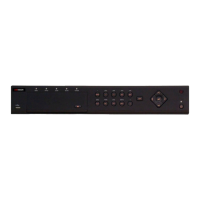
Do you have a question about the HIKVISION DS-7208HGHI-SH and is the answer not in the manual?
| Product color | Black |
|---|---|
| Channels quantity | 8 channels |
| Total storage capacity | 12000 GB |
| Video compression formats | H.264 |
| Playback resolutions supported | 1920 x 1080, 1280 x 1024, 1280 x 720, 1024 x 768 |
| Audio input | 1 |
| BNC input ports | 8 |
| USB 2.0 ports quantity | 2 |
| Ethernet interface type | Fast Ethernet |
| Supported network protocols | TCP/IP, PPPoE, DHCP, DNS, DDNS, NTP, SADP, SMTP, SNMP, NFS, iSCSI, UPnP, HTTPS |
| HDD interface | Serial ATA |
| Power requirements | 12V DC |
| Power consumption (typical) | 20 W |
| Operating temperature (T-T) | -10 - 55 °C |
| Operating relative humidity (H-H) | 10 - 90 % |
| Dimensions (WxDxH) | 315 x 242 x 45 mm |
|---|
Details on FCC compliance and conditions for digital devices, including emission standards.
Information on CE marking and compliance with European directives like LVD, EMC, and RoHS.
Description of the front panel indicators and buttons for various DVR models.
Explanation of how to use the IR remote control and troubleshooting steps.
Guide on using a USB mouse for DVR control, detailing click and scroll actions.
Description of the soft keyboard layout and icon functions for input.
Detailed overview of the rear panel connectors and their functions for various DVR models.
Procedures for safely starting, shutting down, and rebooting the DVR.
Step-by-step guide for initial DVR setup using the configuration wizard.
Instructions for adding and managing IP cameras connected to the DVR.
Overview of the live view function and its on-screen icons.
Details on performing various operations within the live view interface.
Configuration for reducing bandwidth usage for remote viewing of multiple channels.
Customizing live view display settings like output interface and dwell time.
Performing manual checks on analog channel video quality and viewing results.
Procedure for logging out of the system to return to live view mode.
Setting up RS-485 parameters and PTZ camera configurations.
Configuring and calling PTZ presets, patrols, and patterns for camera control.
Overview of the PTZ panel icons and their functions for camera operation.
Setting up recording parameters like resolution, bitrate, and pre/post-record time.
Setting up daily and holiday recording schedules for cameras.
Configuring motion detection parameters and alarm response actions.
Setting up recording triggered by external alarm inputs.
Instructions for enabling and disabling manual recording.
Setting up specific recording schedules for holidays.
Enabling redundant recording for enhanced data safety and reliability.
Grouping HDDs to manage recording files across multiple storage devices.
Methods to protect recorded files by locking or setting HDD to read-only.
Methods for playing back recorded video files by channel, time, or event.
Advanced playback features like frame-by-frame, smart search, and digital zoom.
Procedures for backing up record files using USB devices or eSATA HDDs.
Management of USB flash drives, USB HDDs, and USB writers for backup.
Configuring motion detection parameters, detection areas, and arming schedules.
Setting up handling methods for external sensor alarms and their response actions.
Configuring detection of video loss and setting alarm response actions.
Setting up video tampering detection and configuring arming schedules.
Configuring continuous video quality diagnostics and linkage actions.
Configuring how the system handles various exceptions like HDD full or network disconnect.
Defining actions taken when an alarm occurs, like screen monitoring or email notification.
Manually triggering or clearing alarm outputs for testing or specific events.
Setting up basic network parameters like IP address and working mode.
Advanced network configurations including PPPoE, DDNS, NTP, SNMP, and UPnP.
Monitoring real-time network traffic information like linking status and rates.
Tools for testing network delay, packet loss, and checking network status.
Procedure for initializing newly installed hard disk drives before use.
Adding and configuring NAS or IP SAN disks as network HDDs.
Configuring external eSATA devices for recording or export.
Organizing multiple HDDs into groups for managed recording.
Allocating specific storage quotas for recorded files per camera.
Viewing the status of installed HDDs for maintenance and failure detection.
Accessing HDD Self-Monitoring, Analysis, and Reporting Technology data.
Performing HDD bad sector detection to check disk health.
Setting up alarms for HDD errors like uninitialized or abnormal status.
Customizing on-screen display settings like date, time, and camera name.
Setting up privacy mask zones to obscure specific areas in the video feed.
Adjusting image parameters such as brightness, contrast, and sharpness.
Accessing system details like device, camera, record, alarm, network, and HDD information.
Searching, viewing, and exporting system operation and event log files.
Managing IP camera configuration data via import/export functionality.
Backing up and restoring DVR configuration settings.
Methods for upgrading the DVR firmware via local device or FTP server.
Procedure to reset device parameters to factory default settings.
Setting up RS-232 serial port parameters for configuration or transparent channel.
Configuring general system settings like language, resolution, and time.
Setting up Daylight Saving Time adjustments for accurate timekeeping.
Adjusting device name, output brightness, auto logout, and menu output mode.
Adding, deleting, and editing user accounts and their permissions.
Procedures for logging out, shutting down, or rebooting the DVR.
Definitions of technical terms and acronyms used in the manual.
Common issues and solutions for device startup, image display, and HDD problems.
Table detailing compatible Hikvision IP camera models and their specifications.











